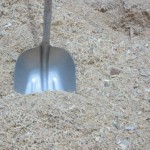This article was published under the title “Move Your Biomass” as the cover story in the May – June 2010 issue of Canadian Biomass Magazine. Read it online at:
http://www.canadianbiomassmagazine.ca/index.php?option=com_content&task=view&id=1781&Itemid=132
Biomass is not an easy material to handle. It  appears in a myriad of species, forms and sizes; it knits together, doesn’t flow well, consolidates and packs easily; it can have a wide range of moisture contents, basic and bulk densities and calorific values; it will freeze; it is very dusty, catches fire easily and is self-combustible; it can contain all manner of contaminants. Conversely, wood pellets are uniform in size and moisture content, are very free flowing, but are quite fragile and easily degrade and require special handling.
appears in a myriad of species, forms and sizes; it knits together, doesn’t flow well, consolidates and packs easily; it can have a wide range of moisture contents, basic and bulk densities and calorific values; it will freeze; it is very dusty, catches fire easily and is self-combustible; it can contain all manner of contaminants. Conversely, wood pellets are uniform in size and moisture content, are very free flowing, but are quite fragile and easily degrade and require special handling.
Increasing numbers of power utilities are eyeing biomass as a source of fuel, primarily as a means of lowering CO2 emissions. New biomass boilers are being constructed but many coal-fired boilers are being converted for co-firing biomass or converted to 100% biomass. Biomass can be introduced into combustors as `hog fuel’, wood pellets or injected as a powder. Working in the forest and converting the wood into usable products is part of the Canadian heritage. There are many people and companies who have extensive experience handling woody biomass in all its myriad of forms. However, with the recent rush to `green energy’ and the identification of woody biomass as a green fuel, there are a lot of interested and well-intentioned but woefully inexperienced people vying for various grants and proposing new projects, but who have little or no experience with biomass.
 Care must be taken in the design of your biomass handling system whatever the form. The topic of design is as varied and complex as the material and the intent in this article is to cover woody biomass, in the form of hog fuel and pellets, which is utilized as fuel. I will discuss the subject in a broad-brush manner suitable for this publication. Following is a list and short description of things to consider when designing your system. Continue reading →
Care must be taken in the design of your biomass handling system whatever the form. The topic of design is as varied and complex as the material and the intent in this article is to cover woody biomass, in the form of hog fuel and pellets, which is utilized as fuel. I will discuss the subject in a broad-brush manner suitable for this publication. Following is a list and short description of things to consider when designing your system. Continue reading →
